Analytics and Trends over Time of Wildfires in Protected Areas in Greece and Other Mediterranean Countries
Abstract
1. Introduction
2. Methods
2.1. Data
2.2. Analysis
2.2.1. Wildfires in Greece
2.2.2. Wildfires in Protected Areas in Greece
2.2.3. Wildfires in Protected Areas in Mediterranean Countries
3. Results
3.1. Wildfires in Greece
3.2. Wildfires in Protected Areas in Greece
3.3. Wildfires in Protected Areas in Mediterranean Countries
4. Discussion
4.1. Wildfires in Greece
4.2. Climate Change
4.3. Wildfire Size—Natura Burn Percentage
4.4. Wildfires in Protected Areas in Greece
4.5. Wildfires in Protected Areas
4.6. Policy Implications
4.7. Synthesis
Funding
Acknowledgments
Conflicts of Interest
References
- Pyne, S.J. Fire: A Brief History; University of Washington Press: Seattle, WA, USA, 2019. [Google Scholar]
- Berčák, R.; Holuša, J.; Trombik, J.; Resnerová, K.; Hlásny, T. A Combination of Human Activity and Climate Drives Forest Fire Occurrence in Central Europe: The Case of the Czech Republic. Fire 2024, 7, 109. [Google Scholar] [CrossRef]
- Knutzen, F.; Averbeck, P.; Barrasso, C.; Bouwer, L.M.; Gardiner, B.; Grünzweig, J.M.; Hänel, S.; Haustein, K.; Johannessen, M.R.; Kollet, S.; et al. Impacts on and damage to European forests from the 2018–2022 heat and drought events. Nat. Hazards Earth Syst. Sci. 2025, 25, 77–117. [Google Scholar] [CrossRef]
- Doherty, T.S.; Macdonald, K.J.; Nimmo, D.G.; Santos, J.L.; Geary, W.L. Shifting fire regimes cause continent-wide transformation of threatened species habitat. Proc. Natl. Acad. Sci. USA 2024, 121, e2316417121. [Google Scholar] [CrossRef]
- Hetzer, J.; Forrest, M.; Ribalaygua, J.; Prado-López, C.; Hickler, T. The fire weather in Europe: Large-scale trends towards higher danger. Environ. Res. Lett. 2024, 19, 084017. [Google Scholar] [CrossRef]
- Colantoni, A.; Egidi, G.; Quaranta, G.; D’Alessandro, R.; Vinci, S.; Turco, R.; Salvati, L. Sustainable Land Management, Wildfire Risk and the Role of Grazing in Mediterranean Urban-Rural Interfaces: A Regional Approach from Greece. Land 2020, 9, 21. [Google Scholar] [CrossRef]
- Babrauskas, V. Electricity-Caused Wildland Fires: Costs, Social Fairness, and Proposed Solution. Fire 2024, 7, 442. [Google Scholar] [CrossRef]
- San Miguel Ayanz, J.; Moreno, J.M.; Camia, A. Analysis of large fires in European Mediterranean landscapes: Lessons learned and perspectives. For. Ecol. Manag. 2013, 294, 11–22. [Google Scholar] [CrossRef]
- Castellet-Viciano, L.; Hernández-Chover, V.; Hernández-Sancho, F. The economic and environmental impact of fire preventive strategies in the Mediterranean region. J. Environ. Manag. 2024, 371, 123095. [Google Scholar] [CrossRef]
- Kala, C.P. Environmental and socioeconomic impacts of forest fires: A call for multilateral cooperation and management interventions. Nat. Hazards Res. 2023, 3, 286–294. [Google Scholar] [CrossRef]
- Santín, C.; Moustakas, A.; Doerr, S.H. Searching the flames: Trends in global and regional public interest in wildfires. Environ. Sci. Policy 2023, 146, 151–161. [Google Scholar] [CrossRef]
- Kelly, L.T.; Giljohann, K.M.; Duane, A.; Aquilué, N.; Archibald, S.; Batllori, E.; Bennett, A.F.; Buckland, S.T.; Canelles, Q.; Clarke, M.F. Fire and biodiversity in the Anthropocene. Science 2020, 370, eabb0355. [Google Scholar] [CrossRef] [PubMed]
- Moustakas, A. Fire acting as an increasing spatial autocorrelation force: Implications for pattern formation and ecological facilitation. Ecol. Complex. 2015, 21, 142–149. [Google Scholar] [CrossRef]
- Matossian, A.; Matsinos, Y.; Konstantinidis, P.; Moustakas, A. Post-fire succession indices performance in a Mediterranean ecosystem. Stoch. Environ. Res. Risk Assess. 2013, 27, 323–335. [Google Scholar] [CrossRef]
- Panagiotaras, D.; Kokkoris, I.P.; Avramidis, P.; Papoulis, D.; Koulougliotis, D.; Gianni, E.; Lekka, D.; Christodoulopoulos, D.C.; Nifora, D.; Druvari, D.; et al. A Local-Scale, Post-Fire Assessment in a Double-Burned Area: A Case Study from Peloponnisos, Greece. Land 2024, 13, 982. [Google Scholar] [CrossRef]
- Sommers, W.T.; Loehman, R.A.; Hardy, C.C. Wildland fire emissions, carbon, and climate: Science overview and knowledge needs. For. Ecol. Manag. 2014, 317, 1–8. [Google Scholar] [CrossRef]
- González-Pérez, J.A.; González-Vila, F.J.; Almendros, G.; Knicker, H. The effect of fire on soil organic matter—A review. Environ. Int. 2004, 30, 855–870. [Google Scholar] [CrossRef]
- Shakesby, R.A.; Doerr, S.H. Wildfire as a hydrological and geomorphological agent. Earth Sci. Rev. 2006, 74, 269–307. [Google Scholar] [CrossRef]
- Hemes, K.S.; Norlen, C.A.; Wang, J.A.; Goulden, M.L.; Field, C.B. The magnitude and pace of photosynthetic recovery after wildfire in California ecosystems. Proc. Natl. Acad. Sci. USA 2023, 120, e2201954120. [Google Scholar] [CrossRef]
- Kalapodis, N.; Sakkas, G. Integrated Fire Management and Closer to Nature Forest Management at the Landscape Scale as a Holistic Approach to Foster Forest Resilience to Wildfires [version 4; peer review: 4 approved with reservations, 2 not approved]. Open Res. Eur. 2025, 4, 131. [Google Scholar] [CrossRef]
- Ferreira, C.; Pinto, L.C.; Valente, M. Forest fire causes and prevention strategies in Portugal: Insights from stakeholder focus groups. For. Policy Econ. 2024, 169, 103330. [Google Scholar] [CrossRef]
- Lopes, M.; Monteiro, A.; Mouzourides, P.; Κouis, P. The health burden of wildfire smoke in a changing climate: Exposure, risks, and strategies for mitigation. Curr. Opin. Environ. Sci. Health 2025, 46, 100631. [Google Scholar] [CrossRef]
- Tsiafouli, M.A.; Apostolopoulou, E.; Mazaris, A.D.; Kallimanis, A.S.; Drakou, E.G.; Pantis, J.D. Human Activities in Natura 2000 Sites: A Highly Diversified Conservation Network. Environ. Manag. 2013, 51, 1025–1033. [Google Scholar] [CrossRef] [PubMed]
- San Miguel Ayanz, J.; Durrant, T.; Boca, R.; Maianti, P.; Liberta, G.; Oom, D.; Branco, A.; De, R.; Suarez, M.M.; Ferrari, D. Advance Report on Forest Fires in Europe, Middle East and North Africa 2023; JRC Techical Report 137375; Publications Office of the European Union: Luxembourg, 2023. [Google Scholar] [CrossRef]
- Myers, N.; Mittermeier, R.A.; Mittermeier, C.G.; Da Fonseca, G.A.; Kent, J. Biodiversity hotspots for conservation priorities. Nature 2000, 403, 853–858. [Google Scholar] [CrossRef] [PubMed]
- OECD. Environmental Performance Reviews: Greece 2020; OECD: Paris, France, 2020. [Google Scholar]
- Hoffmann, S. Challenges and opportunities of area-based conservation in reaching biodiversity and sustainability goals. Biodivers. Conserv. 2022, 31, 325–352. [Google Scholar] [CrossRef]
- Carvalho, F.; Pradhan, A.; Abrantes, N.; Campos, I.; Keizer, J.J.; Cássio, F.; Pascoal, C. Wildfire impacts on freshwater detrital food webs depend on runoff load, exposure time and burnt forest type. Sci. Total Environ. 2019, 692, 691–700. [Google Scholar] [CrossRef]
- Nemens, D.G.; Kidd, K.R.; Varner, J.M.; Wing, B. Recurring wildfires provoke type conversion in dry western forests. Ecosphere 2022, 13, e4184. [Google Scholar] [CrossRef]
- Tsiftsis, S.; Thomasoulis, K.; Chrysostomidis, C.; Merou, T. The effect of fire on the female pollination success of two non-rewarding orchid species. J. Nat. Conserv. 2025, 84, 126848. [Google Scholar] [CrossRef]
- Arrogante-Funes, F.; Aguado, I.; Chuvieco, E. Global impacts of fire regimes on wildland bird diversity. Fire Ecol. 2024, 20, 25. [Google Scholar] [CrossRef]
- Singh, S. Forest fire emissions: A contribution to global climate change. Front. For. Glob. Chang. 2022, 5, 925480. [Google Scholar] [CrossRef]
- Hertelendy, A.J.; Howard, C.; Sorensen, C.; Ranse, J.; Eboreime, E.; Henderson, S.; Tochkin, J.; Ciottone, G. Seasons of smoke and fire: Preparing health systems for improved performance before, during, and after wildfires. Lancet Planet. Health 2024, 8, e588–e602. [Google Scholar] [CrossRef]
- Arellano del Verbo, G.; Urbieta, I.R.; Moreno, J.M. Large-Fire Ignitions Are Higher in Protected Areas than Outside Them in West-Central Spain. Fire 2023, 6, 28. [Google Scholar] [CrossRef]
- EEA. Terrestrial Protected Area Coverage by Country and in the EU-27 by End of 2022. European Environmental Agency (EEA). Modified 29 Nov 2024. Available online: https://www.eea.europa.eu/en/analysis/indicators/terrestrial-protected-areas-in-europe/terrestrial-protected-area-coverage (accessed on 23 July 2025).
- Box, G.E.; Jenkins, G.M.; Reinsel, G.C.; Ljung, G.M. Time Series Analysis: Forecasting and Control; John Wiley & Sons: Hoboken, NJ, USA, 2015. [Google Scholar]
- Cleveland, W.S. Robust Locally Weighted Regression and Smoothing Scatterplots. J. Am. Stat. Assoc. 1979, 74, 829–836. [Google Scholar] [CrossRef]
- You, C.; Lin, D.K.J.; Young, S.S. Time series smoother for effect detection. PLoS ONE 2018, 13, e0195360. [Google Scholar] [CrossRef]
- Nelder, J.A.; Baker, R.J. Generalized Linear Models; Wiley Online Library: Hoboken, NJ, USA, 1972. [Google Scholar]
- Everitt, B.S. Bubble plot. In Wiley StatsRef: Statistics Reference Online; John Wiley & Sons, Ltd.: Hoboken, NJ, USA, 2014. [Google Scholar]
- Papoulis, A.; Pillai, S.U. Probability, Random Variables, and Stochastic Processes; Tata McGraw-Hill Education: Columbus, OH, USA, 2002. [Google Scholar]
- Giannaros, T.M.; Papavasileiou, G.; Lagouvardos, K.; Kotroni, V.; Dafis, S.; Karagiannidis, A.; Dragozi, E. Meteorological Analysis of the 2021 Extreme Wildfires in Greece: Lessons Learned and Implications for Early Warning of the Potential for Pyroconvection. Atmosphere 2022, 13, 475. [Google Scholar] [CrossRef]
- Misseyanni, A.; Christopoulou, A.; Kougkoulos, I.; Vassilakis, E.; Arianoutsou, M. The Impact of Forest Fires on Ecosystem Services: The Case of Greece. Forests 2025, 16, 533. [Google Scholar] [CrossRef]
- Xanthopoulos, G.; Athanasiou, M.; Kaoukis, K. Suppression versus prevention–The disastrous forest fire season of 2021 in Greece. Wildfire Quart. 2022, 2, 18–24. [Google Scholar]
- Michailidis, K.; Garane, K.; Karagkiozidis, D.; Peletidou, G.; Voudouri, K.-A.; Balis, D.; Bais, A. Extreme wildfires over northern Greece during summer 2023—Part A: Effects on aerosol optical properties and solar UV radiation. Atmos. Res. 2024, 311, 107700. [Google Scholar] [CrossRef]
- Kalogiannidis, S.; Kalfas, D.; Zagkas, T.; Chatzitheodoridis, F. Assessing the Effect of Community Preparedness on Property Damage Costs during Wildfires: A Case Study of Greece. Fire 2024, 7, 279. [Google Scholar] [CrossRef]
- Rovithakis, A.; Grillakis, M.G.; Seiradakis, K.D.; Giannakopoulos, C.; Karali, A.; Field, R.; Lazaridis, M.; Voulgarakis, A. Future climate change impact on wildfire danger over the Mediterranean: The case of Greece. Environ. Res. Lett. 2022, 17, 045022. [Google Scholar] [CrossRef]
- COPERNICUS. 3.2.4 Transitional Woodland/Shrub. Available online: https://land.copernicus.eu/content/corine-land-cover-nomenclature-guidelines/html/index-clc-324.html (accessed on 13 August 2025).
- Zhou, R.; Ci, X.; Hu, J.; Zhang, X.; Cao, G.; Xiao, J.; Liu, Z.; Li, L.; Thornhill, A.H.; Conran, J.G.; et al. Transitional areas of vegetation as biodiversity hotspots evidenced by multifaceted biodiversity analysis of a dominant group in Chinese evergreen broad-leaved forests. Ecol. Indic. 2023, 147, 110001. [Google Scholar] [CrossRef]
- Gemitzi, A.; Albarakat, R.; Kratouna, F.; Lakshmi, V. Land cover and vegetation carbon stock changes in Greece: A 29-year assessment based on CORINE and Landsat land cover data. Sci. Total Environ. 2021, 786, 147408. [Google Scholar] [CrossRef] [PubMed]
- Chouvardas, D.; Karatassiou, M.; Stergiou, A.; Chrysanthopoulou, G. Identifying the Spatiotemporal Transitions and Future Development of a Grazed Mediterranean Landscape of South Greece. Land 2022, 11, 2141. [Google Scholar] [CrossRef]
- Shi, Y.; Wei, W. Terracing drives Chinese Loess Plateau toward carbon neutrality: Spatiotemporal interaction between land use transitions and SOC storage. J. Environ. Manag. 2025, 385, 125760. [Google Scholar] [CrossRef]
- Vicente-Serrano, S.M.; Tramblay, Y.; Reig, F.; González-Hidalgo, J.C.; Beguería, S.; Brunetti, M.; Kalin, K.C.; Patalen, L.; Kržič, A.; Lionello, P.; et al. High temporal variability not trend dominates Mediterranean precipitation. Nature 2025, 639, 658–666. [Google Scholar] [CrossRef]
- Mahecha, M.D.; Bastos, A.; Bohn, F.; Eisenhauer, N.; Feilhauer, H.; Hickler, T.; Kalesse-Los, H.; Migliavacca, M.; Otto, F.E.L.; Peng, J. Biodiversity and climate extremes: Known interactions and research gaps. Earth’s Future 2024, 12, e2023EF003963. [Google Scholar] [CrossRef]
- De Frenne, P.; Zellweger, F.; Rodríguez-Sánchez, F.; Scheffers, B.R.; Hylander, K.; Luoto, M.; Vellend, M.; Verheyen, K.; Lenoir, J. Global buffering of temperatures under forest canopies. Nat. Ecol. Evol. 2019, 3, 744–749. [Google Scholar] [CrossRef] [PubMed]
- Vangi, E.; Dalmonech, D.; Cioccolo, E.; Marano, G.; Bianchini, L.; Puchi, P.F.; Grieco, E.; Cescatti, A.; Colantoni, A.; Chirici, G.; et al. Stand age diversity (and more than climate change) affects forests’ resilience and stability, although unevenly. J. Environ. Manag. 2024, 366, 121822. [Google Scholar] [CrossRef]
- Oikonomou, P.; Karathanassi, V.; Andronis, V.; Papoutsis, I. Assessing and Forecasting Natural Regeneration in Mediterranean Landscapes After Wildfires. Remote Sens. 2025, 17, 897. [Google Scholar] [CrossRef]
- Arianoutsou, M.; Athanasakis, G.; Kazanis, D.; Christopoulou, A. Attica: A Hot Spot for Forest Fires in Greece. Fire 2024, 7, 467. [Google Scholar] [CrossRef]
- Xu, W.; He, H.S.; Huang, C.; Duan, S.; Hawbaker, T.J.; Henne, P.D.; Liang, Y.; Zhu, Z. Large fires or small fires, will they differ in affecting shifts in species composition and distributions under climate change? For. Ecol. Manag. 2022, 510, 120131. [Google Scholar] [CrossRef]
- Kirkland, M.; Atkinson, P.W.; Pearce-Higgins, J.W.; de Jong, M.C.; Dowling, T.P.; Grummo, D.; Critchley, M.; Ashton-Butt, A. Landscape fires disproportionally affect high conservation value temperate peatlands, meadows, and deciduous forests, but only under low moisture conditions. Sci. Total Environ. 2023, 884, 163849. [Google Scholar] [CrossRef] [PubMed]
- Spadoni, G.L.; Moris, J.V.; Vacchiano, G.; Elia, M.; Garbarino, M.; Sibona, E.; Tomao, A.; Barbati, A.; Sallustio, L.; Salvati, L.; et al. Active governance of agro-pastoral, forest and protected areas mitigates wildfire impacts in Italy. Sci. Total Environ. 2023, 890, 164281. [Google Scholar] [CrossRef]
- Resco de Dios, V.; Schütze, S.J.; Cunill Camprubí, À.; Balaguer-Romano, R.; Boer, M.M.; Fernandes, P.M. Protected areas as hotspots of wildfire activity in fire-prone Temperate and Mediterranean biomes. J. Environ. Manag. 2025, 385, 125669. [Google Scholar] [CrossRef] [PubMed]
- Mohapatra, A.; Trinh, T. Early Wildfire Detection Technologies in Practice—A Review. Sustainability 2022, 14, 12270. [Google Scholar] [CrossRef]
- Medewar, A.G.; Sawarkar, A.D.; Kshirsagar, U.v. A Review on Fire and Smoke Detection With Intelligent Control for Enhanced Safety Using Machine Learning (ML) and Internet of Things (IoT). Cureus 2024, 1, e10. [Google Scholar] [CrossRef]
- Yebra, M.; Mahony, R.; Debus, R. Technological solutions for living with fire in the age of megafires. One Earth 2024, 7, 932–935. [Google Scholar] [CrossRef]
- McArthur, A.G.; Cheney, N.P. The Characterization of Fires in Relation to Ecological Studies. Fire Ecol. 2015, 11, 3–9. [Google Scholar] [CrossRef]
- Foster, C.N.; Banks, S.C.; Cary, G.J.; Johnson, C.N.; Lindenmayer, D.B.; Valentine, L.E. Animals as Agents in Fire Regimes. Trends Ecol. Evol. 2020, 35, 346–356. [Google Scholar] [CrossRef]
- Moustakas, A.; Voutsela, A.; Katsanevakis, S. Sampling alien species inside and outside protected areas: Does it matter? Sci. Total Environ. 2018, 625, 194–198. [Google Scholar] [CrossRef]
- Kati, V.; Kassara, C.; Vrontisi, Z.; Moustakas, A. The biodiversity-wind energy-land use nexus in a global biodiversity hotspot. Sci. Total Environ. 2021, 768, 144471. [Google Scholar] [CrossRef]
- Moustakas, A.; Georgiakakis, P.; Kret, E.; Kapsalis, E. Wind turbine power and land cover effects on cumulative bat deaths. Sci. Total Environ. 2023, 892, 164536. [Google Scholar] [CrossRef] [PubMed]
- Mammides, C.; Zotos, S.; Martini, F. Quantifying the amount of land lost to artificial surfaces in European habitats: A comparison inside and outside Natura 2000 sites using a quasi-experimental design. Biol. Conserv. 2024, 293, 110556. [Google Scholar] [CrossRef]
- Kati, V.; Kassara, C.; Panagos, P.; Tampouratzi, L.; Gotsis, D.; Tzortzakaki, O.; Petridou, M.; Psaralexi, M.; Sidiropoulos, L.; Vasilakis, D.; et al. The overlooked threat of land take from wind energy infrastructures: Quantification, drivers and policy gaps. J. Environ. Manag. 2023, 348, 119340. [Google Scholar] [CrossRef] [PubMed]
- Souliotis, Y. Attica Wildfire in August Caused by Falling Power Cable, Report Finds; Kathimerini: Athens, Greece, 7 December.
- Kathimerini. Power Lines Are Greece’s Top Wildfire Threat; Kathimerini: Athens, Greece, 11 June.
- Papadopoulos, Y. When Wildfires Are Started by Faulty Pylons; Kathimerini: Athens, Greece.
- BBC. Greek Forest Fire Close to Athens; BBC: London, UK, 29 June.
- Eagleston, H.; Bester, M.; Yusuf, J.; Damodaran, A.; Reno, M.J. Systemic Drivers of Electric-Grid-Caused Catastrophic Wildfires: Implications for Resilience in the United States. Challenges 2025, 16, 13. [Google Scholar] [CrossRef]
- Bandara, S.; Rajeev, P.; Gad, E. Power Distribution System Faults and Wildfires: Mechanisms and Prevention. Forests 2023, 14, 1146. [Google Scholar] [CrossRef]
- Troumbis, A.Y.; Gaganis, C.M.; Sideropoulos, H. Probabilistic Wildfire Risk Assessment and Modernization Transitions: The Case of Greece. Fire 2023, 6, 158. [Google Scholar] [CrossRef]
- Athanasiou, M.; Bouchounas, T.; Korakaki, E.; Tziritis, I.; Xanthopoulos, G.; Sitara, S. Introducing the use of fire for wildfire prevention in Greece: Pilot application of prescribed burning in Chios island. In Advances in Forest Fire Research 2022; Coimbra University Press: Coimbra, Portugal, 2022; pp. 1487–1494. [Google Scholar] [CrossRef]
- Arbinolo, M.; Patimo, G.; Rey, E.; Stokkeland, O.; Verde, J.C.; Casartelli, V.; Marengo, A.; Melinato, S.; Mysiak, J.; Salpina, D.; et al. UCPM Wildfire Peer Review Report: Greece 2024; European Commission: Brussels, Belgium, 2024. [Google Scholar] [CrossRef]
- Morfonios, N. Greece Falls Behind Its Targets for Post-COVID EU Recovery Money. In European Data Journalism Network. 2025. Available online: https://www.europeandatajournalism.eu/cp_data_news/greece-falls-behind-its-targets-for-post-covid-eu-recovery-money/ (accessed on 27 March 2025).
- GOV.GR. NextGenerationEU. Available online: https://greece20.gov.gr/en/at-a-glance/#:~:text=The%20National%20Recovery%20and%20Resilience,REPowerEU (accessed on 25 July 2025).
- Oliveres, J.; Castellnou, M.; Castellarnau, X.; Rosas-Casals, M.; Brotons, L.; Duane, A. The path to strategic fire management planning in the Aran, Pyrenees. Fire Ecol. 2025, 21, 9. [Google Scholar] [CrossRef]
- Palaiologou, P.; Kalabokidis, K.; Troumbis, A.; Day, M.A.; Nielsen-Pincus, M.; Ager, A.A. Socio-ecological perceptions of wildfire management and effects in Greece. Fire 2021, 4, 18. [Google Scholar] [CrossRef]
- Parente, J.; Tonini, M.; Stamou, Z.; Koutsias, N.; Pereira, M. Quantitative Assessment of the Relationship between Land Use/Land Cover Changes and Wildfires in Southern Europe. Fire 2023, 6, 198. [Google Scholar] [CrossRef]
- Dimitrakopoulos, P.G.; Jones, N.; Iosifides, T.; Florokapi, I.; Lasda, O.; Paliouras, F.; Evangelinos, K.I. Local attitudes on protected areas: Evidence from three Natura 2000 wetland sites in Greece. J. Environ. Manag. 2010, 91, 1847–1854. [Google Scholar] [CrossRef]
- Gharesifard, M.; Ceccaroni, L.; Gold, M.; Berti Suman, A.; Das, K. Citizen science and the nexus approach: Unlocking synergies for sustainable development. Sustain. Nexus Forum 2025, 33, 4. [Google Scholar] [CrossRef]
- Katuwal, H.; Kafley, H. Playing with fire: Socioeconomic factors and deliberate wildfires in Texas. J. Environ. Manag. 2024, 370, 122980. [Google Scholar] [CrossRef]
- Bradley, C.; Hanson, C.; DellaSala, D. Does increased forest protection correspond to higher fire severity in frequent-fire forests of the western United States? Ecosphere 2016, 7, e01492. [Google Scholar] [CrossRef]
- Kirkland, M.; Atkinson, P.W.; Aliácar, S.; Saavedra, D.; De Jong, M.C.; Dowling, T.P.F.; Ashton-Butt, A. Protected areas, drought, and grazing regimes influence fire occurrence in a fire-prone Mediterranean region. Fire Ecol. 2024, 20, 88. [Google Scholar] [CrossRef]
- Lambrou, N.; Kolden, C.; Loukaitou-Sideris, A.; Anjum, E.; Acey, C. Social drivers of vulnerability to wildfire disasters: A review of the literature. Landsc. Urban Plan. 2023, 237, 104797. [Google Scholar] [CrossRef]
- Regos, A.; Pais, S.; Campos, J.C.; Lecina-Diaz, J. Nature-based solutions to wildfires in rural landscapes of Southern Europe: Let’s be fire-smart! Int. J. Wildland Fire 2023, 32, 942–950. [Google Scholar] [CrossRef]
- Oliveras Menor, I.; Prat-Guitart, N.; Spadoni, G.L.; Hsu, A.; Fernandes, P.M.; Puig-Gironès, R.; Ascoli, D.; Bilbao, B.A.; Bacciu, V.; Brotons, L.; et al. Integrated fire management as an adaptation and mitigation strategy to altered fire regimes. Commun. Earth Environ. 2025, 6, 202. [Google Scholar] [CrossRef]
- Chas-Amil, M.L.; Prestemon, J.P.; McClean, C.J.; Touza, J. Human-ignited wildfire patterns and responses to policy shifts. Appl. Geogr. 2015, 56, 164–176. [Google Scholar] [CrossRef]
- YPEN. Reports—Studies. Available online: https://ypen.gov.gr/perivallon/viopoikilotita/ektheseis-meletes/ (accessed on 10 February 2025).
- Elvan, O.D.; Birben, Ü.; Özkan, U.Y.; Yıldırım, H.T.; Türker, Y.Ö. Forest fire and law: An analysis of Turkish forest fire legislation based on Food and Agriculture Organization criteria. Fire Ecol. 2021, 17, 12. [Google Scholar] [CrossRef]
- Folharini, S.; Vieira, A.; Bento-Gonçalves, A.; Silva, S.; Marques, T.; Novais, J. Bibliometric Analysis on Wildfires and Protected Areas. Sustainability 2023, 15, 8536. [Google Scholar] [CrossRef]
- Molina, J.R.; González-Cabán, A.; Rodríguez y Silva, F. Wildfires impact on the economic susceptibility of recreation activities: Application in a Mediterranean protected area. J. Environ. Manag. 2019, 245, 454–463. [Google Scholar] [CrossRef] [PubMed]
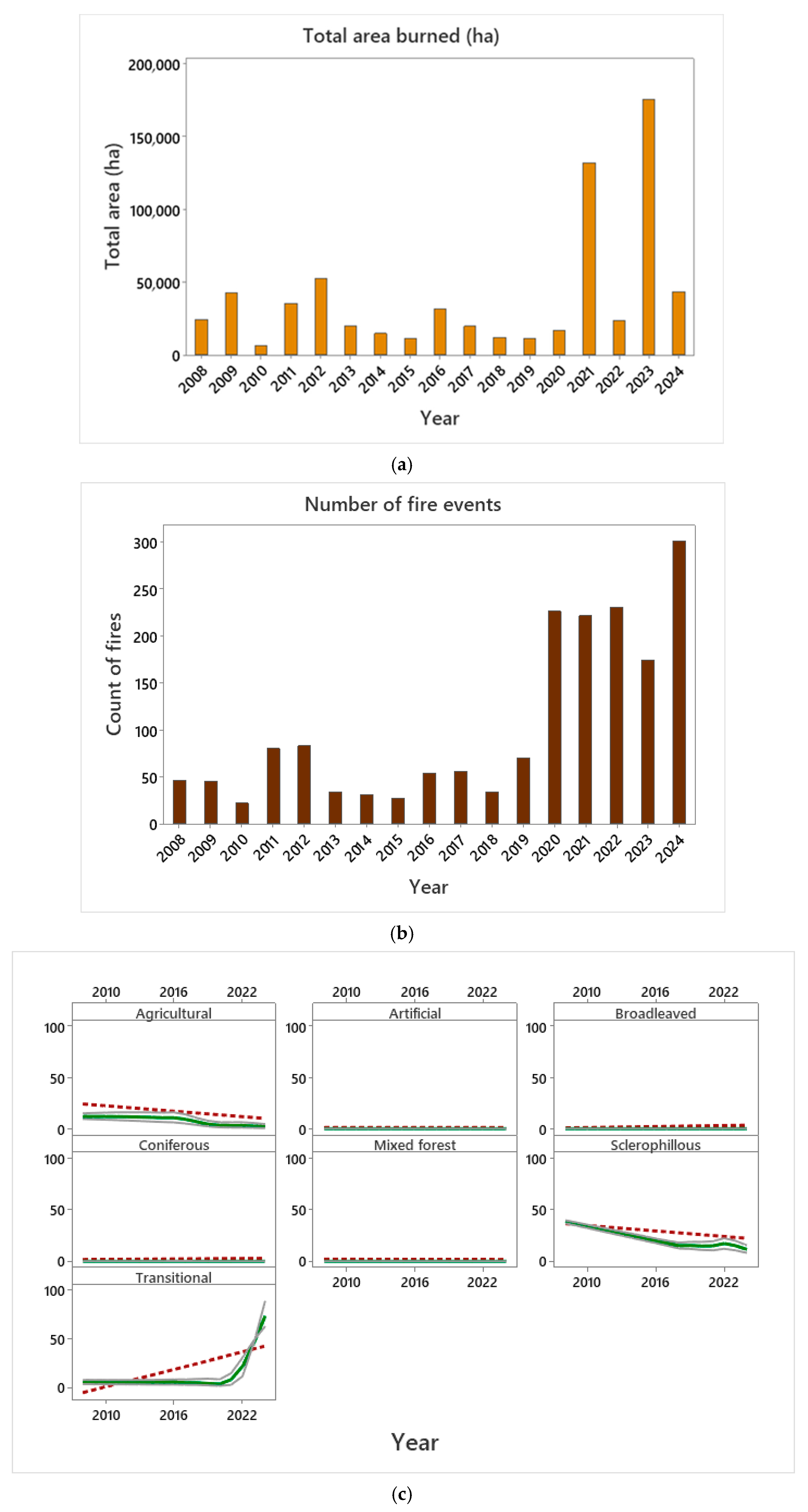
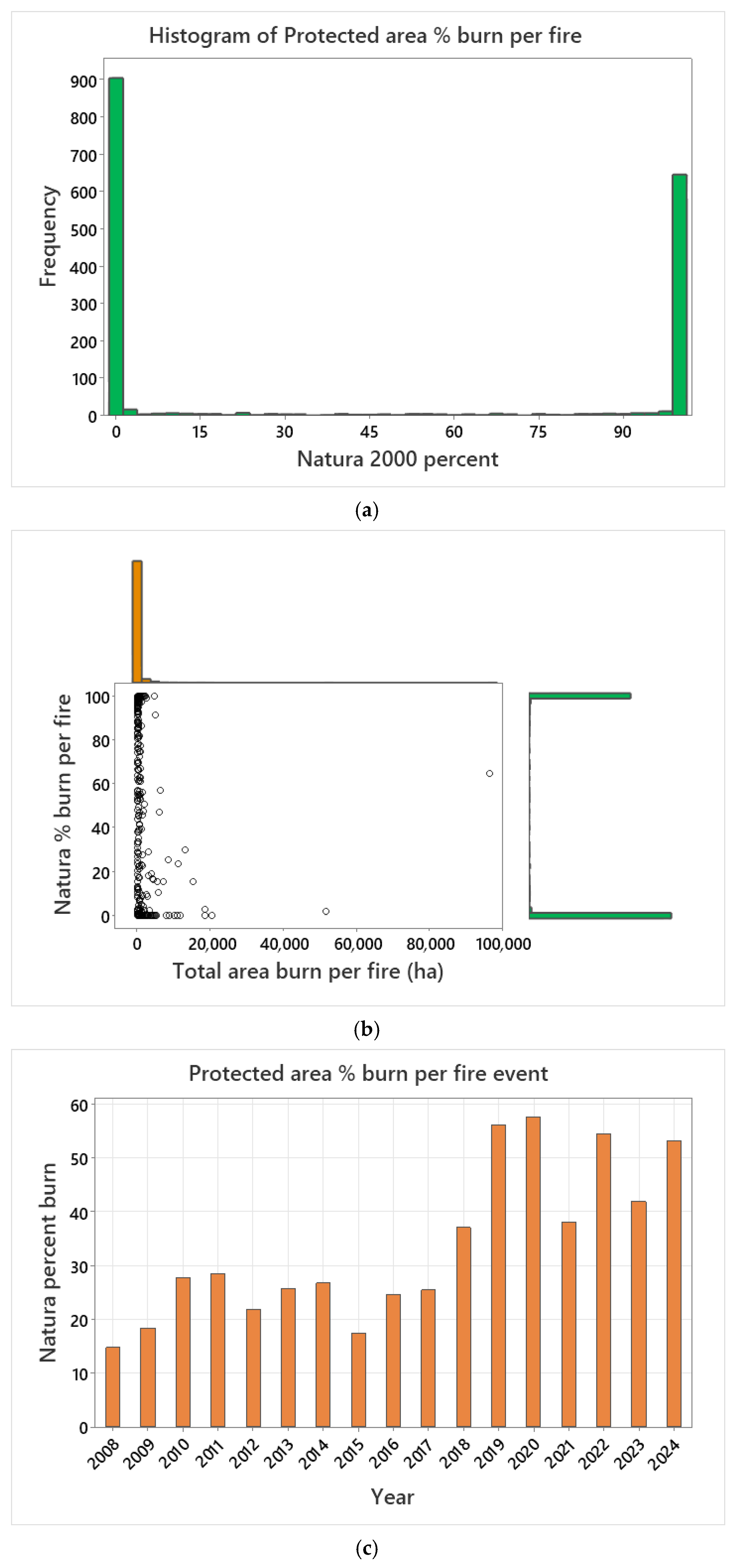
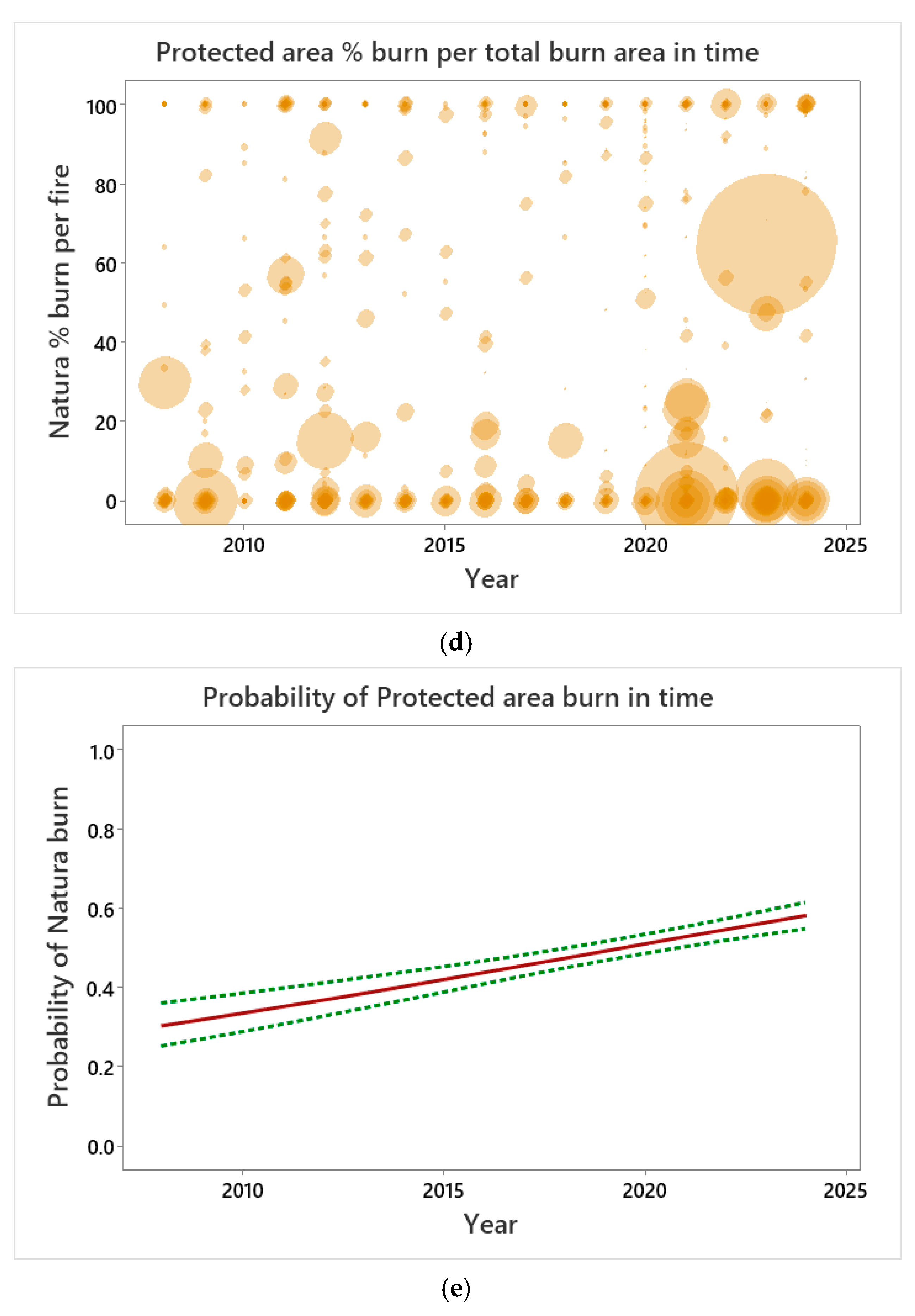
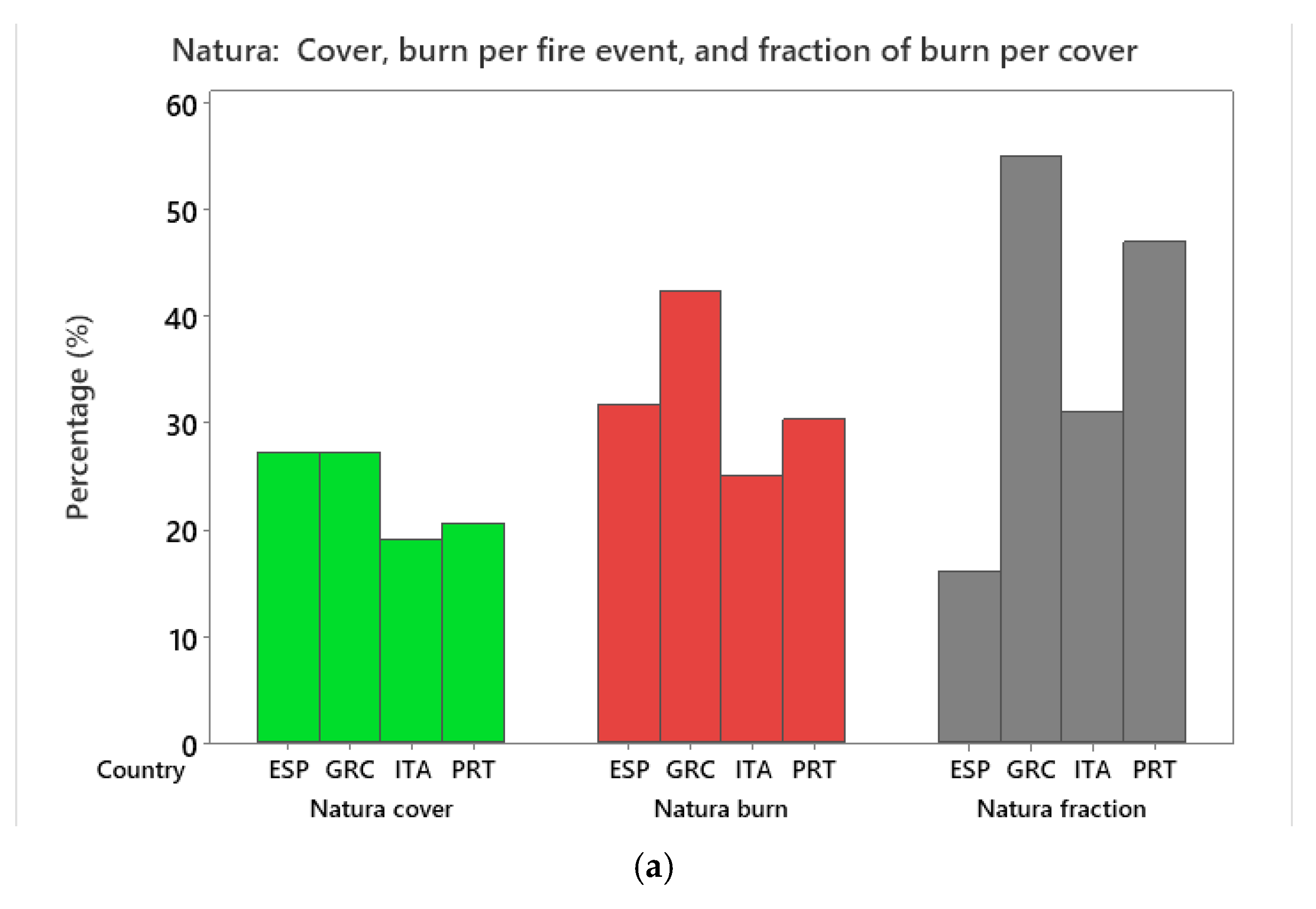
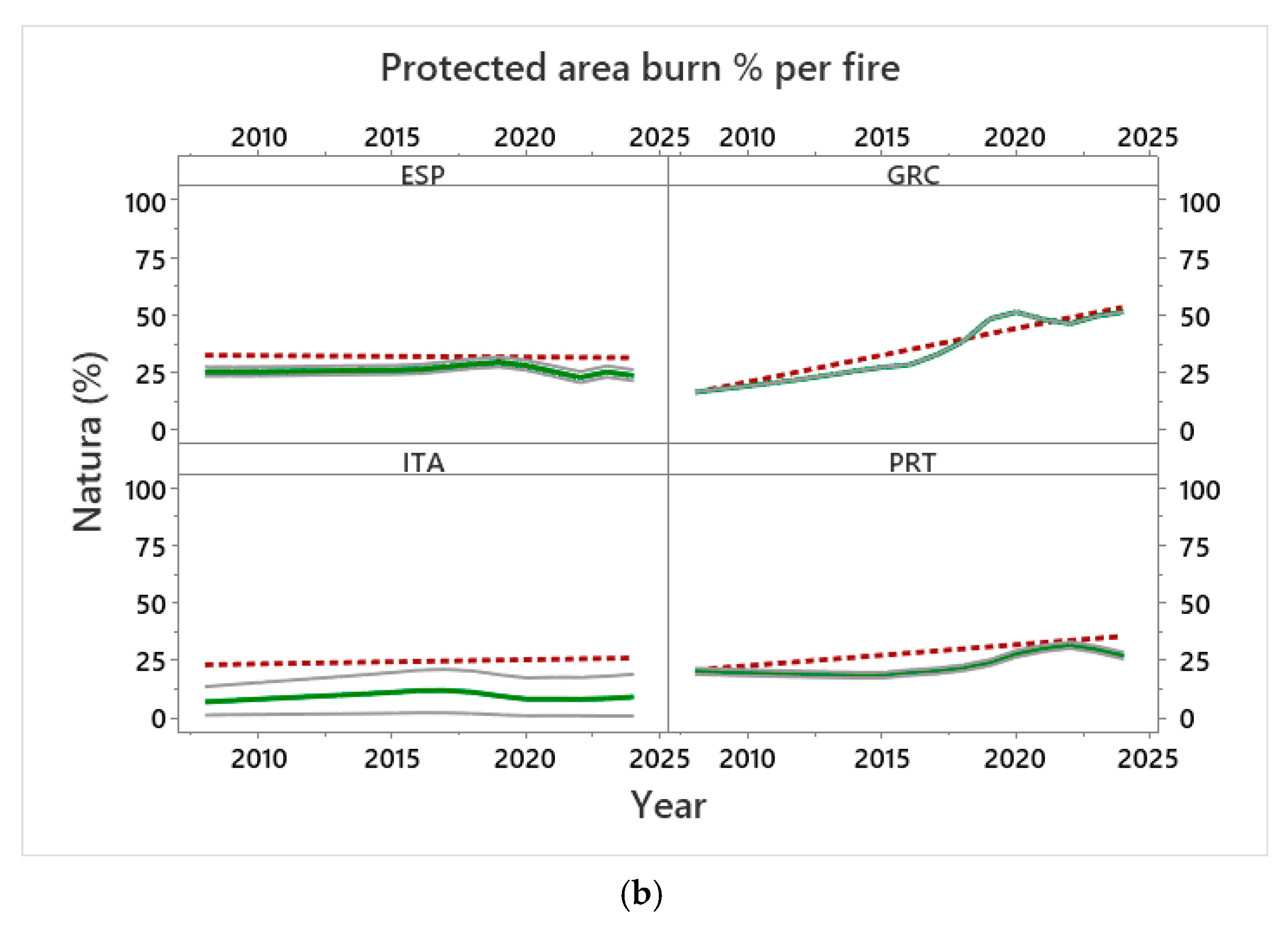
| Descriptive Statistics | ||||
|---|---|---|---|---|
| iso 3 | N | Median | Mean Rank | Z-Value |
| ESP | 7153 | 0 | 13,188.0 | 6.18 |
| GRC | 1734 | 0 | 14,626.0 | 11.1 |
| ITA | 9602 | 0 | 12,054.4 | −11.45 |
| PRT | 6975 | 0 | 12,728.1 | −0.06 |
| Overall | 25,464 | 12,732.5 | ||
| TEST | ||||
| Null hypothesis | H0: All medians are equal | |||
| Alternative hypothesis | H1: At least one median is different | |||
| Method | DF | H-Value | p-value | |
| Not adjusted for ties | 3 | 224.23 | 0.000 | |
| Adjusted for ties | 3 | 307.06 | 0.000 | |
Disclaimer/Publisher’s Note: The statements, opinions and data contained in all publications are solely those of the individual author(s) and contributor(s) and not of MDPI and/or the editor(s). MDPI and/or the editor(s) disclaim responsibility for any injury to people or property resulting from any ideas, methods, instructions or products referred to in the content. |
© 2025 by the author. Licensee MDPI, Basel, Switzerland. This article is an open access article distributed under the terms and conditions of the Creative Commons Attribution (CC BY) license (https://creativecommons.org/licenses/by/4.0/).
Share and Cite
Moustakas, A. Analytics and Trends over Time of Wildfires in Protected Areas in Greece and Other Mediterranean Countries. Fire 2025, 8, 324. https://doi.org/10.3390/fire8080324
Moustakas A. Analytics and Trends over Time of Wildfires in Protected Areas in Greece and Other Mediterranean Countries. Fire. 2025; 8(8):324. https://doi.org/10.3390/fire8080324
Chicago/Turabian StyleMoustakas, Aristides. 2025. "Analytics and Trends over Time of Wildfires in Protected Areas in Greece and Other Mediterranean Countries" Fire 8, no. 8: 324. https://doi.org/10.3390/fire8080324
APA StyleMoustakas, A. (2025). Analytics and Trends over Time of Wildfires in Protected Areas in Greece and Other Mediterranean Countries. Fire, 8(8), 324. https://doi.org/10.3390/fire8080324





